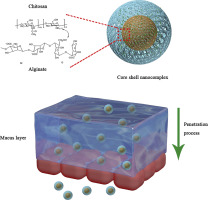Abstract
The objective of this study was to design intestinal mucus-penetrating core-shell nanocomplex by functionally mimicking the surface of virus, which can be used as the carrier for peroral delivery of macromolecules, and further understand the influence of nanocomplex surface properties on the mucosal permeation capacity. Taking insulin as a model drug, the core was formed by the self-assembly among positively charged chitosan, insulin and negatively charged sodium tripolyphosphate, different types of alginates were used as the shell forming material. The nanocomplex was characterized by dynamic light scattering (DLS), atomic force microscopy (AFM) and FTIR. Nanocomplex movement in mucus was recorded using multiple particle tracking (MPT) method. Permeation and uptake of different nanocomplex were studied in rat intestine. It was demonstrated that alginate coating layer was successfully formed on the core and the core-shell nanocomplex showed a good physical stability and improved enzymatic degradation protection. The mucus penetration and MPT study showed that the mucus penetration capacity of the nanocomplex was surface charge and coating polymer structure dependent, nanocomplex with negative alginate coating had 1.6–2.5 times higher mucus penetration ability than that of positively charged chitosan-insulin nanocomplex. Moreover, the mucus penetration ability of the core-shell nanocomplex was alginate structure dependent, whereas alginate with lower G content and lower molecular weight showed the best permeation enhancing ability. The improvement of intestine permeation and intestinal villi uptake of the core-shell nanocomplex were further confirmed in rat intestine and multiple uptake mechanisms were involved in the transport process. In conclusion, core-shell nanocomplex composed of oppositely charged materials could provide a strategy to overcome the mucus barrier and enhance the mucosal permeability.
Conclusion
In this study, hydrophilic high charge density core-shell nanocomplex was developed to increase intestinal mucus penetration ability. Both the surface charge of nanocomplex and structure characteristics of coating layer could influence the performance of drug carriers in the intestine mucus. In comparison with positively charged CS-INS NC, the negatively charged alginate coating layer could decrease the mucus penetrating barrier for nanocomplex, increase villi uptake and intestine permeation. In addition to surface charge of nanocomplex, structures of coating materials can also influence the mucus penetration ability of nanocomplex, and alginates with lower molecular weight and lower G content presented better effect.
Recommended for you

